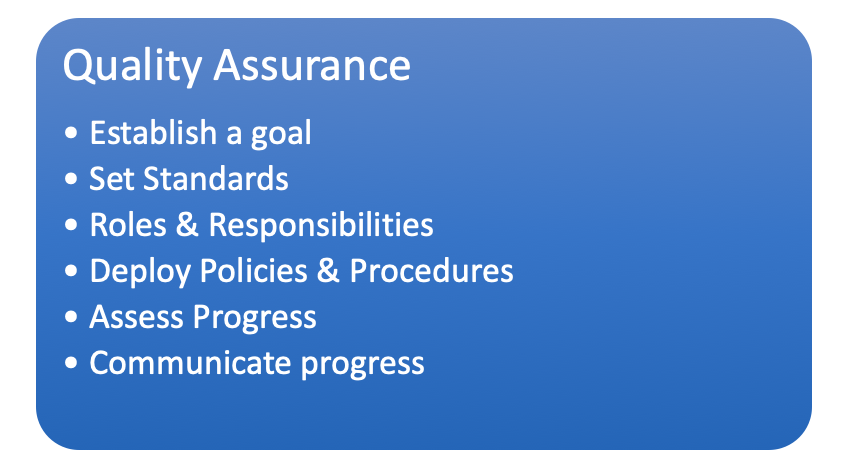Quality assurance provides evidence to a business that it is producing a great product. It involves several aspects, such as establishing an understanding of standards and requirements that must be met together with an assessment of the methods, approach and results achieved pertaining to quality in an organization. Quality Assurance, when operated successfully, can help drive effectiveness and reduce errors.
Quality Assurance provides an effective approach to Quality and one that businesses can use to help steadily and sustainably improve performance.
In today’s post, be exploring how to establish effective Quality Assurance in your organization.
We’ll be covering
- What is the role of Quality Assurance
- Quality Control vs Quality Assurance
- Implementing Quality Assurance
- Standards and objectives
- Roles and responsibilities
- PoliciesProcedures
- Measuring impact/progress
- Continuous Improvement
- Communication
What is the role of Quality Assurance?
Mistakes and errors happen. That’s the first point to establish. You’re highly unlikely to be able to eradicate all issues.
However, what you can do by implementing a Quality Assurance framework is to give your employees the best chance of success with structured processes, knowledge, accountability and mechanisms to monitor and improve performance. |
Quality Assurance doesn’t have to be difficult; as long as you focus on the basic principles (and don’t skip steps), you can…
Quality Control vs Quality Assurance.
Before we start, it’s important to know the difference; Quality Control is not Quality Assurance.
Let’s explore the differences:
Quality Control
Businesses use the process of Quality control to ensure that quality requirements have been achieved.
Quality assurance
Quality Assurance is a methodology (or set of principles) that helps organizations prevent defects during manufacture and ensure quality requirements will be fulfilled.
Implementing Quality Assurance

Implementing Quality Assurance has several facets
- It takes time
- It is not an instant fix to existing problems that you already have
- It requires a plan, most likely staged, which addresses various aspects of the way you do
- business
- It requires leadership support
- It requires buy-in from all levels within th€’business
- It requires investment (in time, People, and resources)
- It requires a team to implement it that operates under a strategy
- It requires a plan; this is not something to be achieved through a hap-hazard approach
- It requires sustaining.
Most Quality Assurance programs will look to the following principles
1. Establishing a goal
It’s likely that you have a key goal in mind when implementing Quality assurance. That might be:
- Improving customer satisfaction (improved products out the door, happier customers)
- Reducing the cost of quality
- Fostering innovation
- Engagement of staff with regards to Quality
Without a goal, you will not be able to measure your progress and see if you have delivered the required change that you hoped you would achieve.
2. Set Standards
Establish documentation that describes the clear standards that your organization needs to achieve. These are likely to cover several aspects of your business, including:
- Compliance
- Policies and procedures
- Checklists
- Roles and responsibilities
- Governance
What you’re trying to achieve with this area is for all members of your organization to understand what they need to achieve and how.
3. Allocate roles and responsibilities
In order to deliver your Quality Assurance goals, you will require a team who will deploy and measure your Quality Assurance plan. This varies on many factors, including organization size, industry, and regulatory burden. Many organizations choose to outsource all or part of it. Large multisize organizations may choose to centralize it. However, you look to deliver your QA plan and establish a team of competent, experienced professionals in order to do so.
4 Deploy your policies and procedures
Having created your standards, you need to roll them out into your business. There are several key enablers for making this a success which includes:
- Transition planning
- Communication
- Document release and management (in the issuance of new processes and policies)
- Performance measurement
There are many ways to do this part, and you shouldn’t underestimate the level of upfront planning in order to make it a success.
5. Assess progress
Once you have implemented your quality assurance system, you’ll want to assess your progress to see if you are delivering on the goals you established. Your assessment should include:
- Metrics
- People impact
- Issues and concerns
6/ Continuous improvement
Remember that your quality assurance plan isn’t fixed; it’s a living, breathing document that can be adjusted in line with performance. Assessment frequencies are likely to vary between organizations. Many will utilize an audit process to verify adherence and progress.
What’s key is that where you find issues is that they are carefully addressed and where required adjustments are made (and rolled out) to your organization.
7/ Communicate
The final element is perhaps the most important. How you communicate all of this is key. You will want a communication plan that
- Communicates your plan
- Communicates your success
- It is two way and allows employees and team members to give feedback
- Includes your leadership
- Highlights issues and concerns
- Demonstrates progress
Summary
Quality Assurance is a key piece in your armoury when it comes to helping your organization meet regulatory and customer requirements.
From the outset, you should realize that it is not simple and will require a dedicated plan and team in order to deploy it.
You should consider pitfalls that you might find along the way and focus efforts on communication, engagement and continuous improvement in order to get the most value from the exercise.
Have you helped deploy quality assurance in your organization? Have you got some lessons learned that you’d like to share with our audience?
Please use our comments section or reach out to us via Twitter; we’d love to hear from you.
